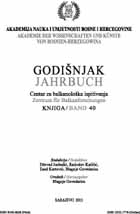Gdje i kad je postojalo bakarno doba
Where and when did Copper Age exist
Author(s): Blagoje GovedaricaSubject(s): Archaeology
Published by: Akademija Nauka i Umjetnosti Bosne i Hercegovine
Summary/Abstract: Mastering the metallurgy of cooper and craft specialisation, as well as the emergence of the stratified society, are the basic characteristics of the Copper Age, as complete cultural and social system which represents separate stage in cultural-historical development of the prehistoric communities. This article presents arguments which show that this defined cultural-historical period existed only in the area of south Eastern Europe during the 5th Millennium BC. Emergence of such cultural stage and its developments in this relatively narrow geographical frame is conditioned by number of natural and social circumstances which were mutually connected only in this area at this particular time. New cultural system has been spread very fast from its native surrounding to eastern Carpathian area and to area between Prut and Dniester, and after to the Carpathian basin in the Northwest. The primary territory of the Copper Age Culture is defined with this. Reception of the new cultural system outside its primary territory was not so large, which can be explained by the fact that early copper metallurgy did not bring important ergonomic advantage in comparison to other raw materials known at that time. Except natural conditions, production of copper required large organizational and technological redirection of existing communities, which also represented aggravating circumstance for the introduction of this new social-economical system. In the immediate and distant neighbourhood either mostly individual import of copper products appeared or extensive processing of the native copper is continued which did not leave important consequences in the traditional autochthonous development. This situation is common for the western Balkans, Albania and Greece, but as it seems also fro the larger Mediterranean area. We meet even less traces of the Copper Age culture in the northern parts of the continent where obviously Neolithic system was still very strong and functional, so it could persist to all those innovations perilous to the traditional ideology. Stronger influence of the Copper Age culture existed only at the heath area in the north of Black Sea. Nomadic groups from this area brought out intensive exchange with developed Balkan cultures, which made impact to their material and social development. Expansion of the Cucuteni-Tripolje culture from west to the area of middle Dnieper contributed to attenuation of the local Mesolithic and Neolithic tradition which made heath cultures more open to new impulses. The well known is the fact that Balkan’s copper reached the Volga area, and it is not excluded that local craftsmen were able to cast some jewellery objects out of imported metal. Cultural system of Balkan Copper age disappeared relatively abrupt in the end of 5th millennium BC. Traditional centres disappeared, and with them mass metallurgical activities.
Journal: Godišnjak Centra za balkanološka ispitivanja
- Issue Year: 2011
- Issue No: 40
- Page Range: 45-61
- Page Count: 17
- Language: Bosnian

